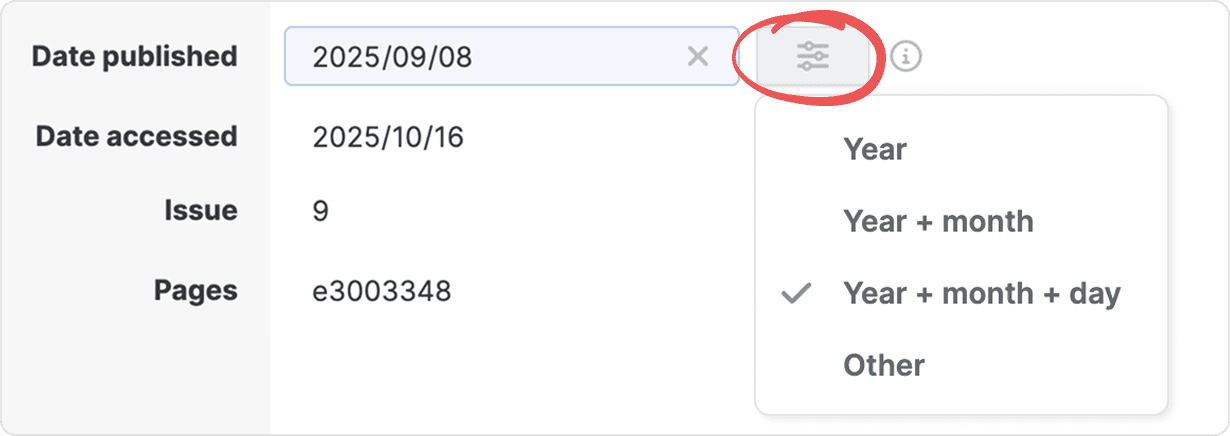Edit title, authors, and other special metadata fields
While most metadata fields in Paperpile are straightforward, some have special behaviors or formatting options that help you create perfectly formatted citations.
This article provides details on these special fields and how to use them effectively when editing a reference.
Type
The Type field determines what kind of reference you're working with—such as journal article, book, or conference paper. This controls which metadata fields are available. For example, a Book will have a Publisher field, while a Journal Article will have a Journal field.
Subtype
Some reference types also have a Subtype field for more specific classification. For example, a journal article can have subtypes like "Research article" or "Review."
Title formatting
You can preserve scientific notation, mathematical expressions, and emphasis for text within the Title field. Select some text within the Title field to show the title formatting toolbar. Choose one of the following actions to apply special formatting:
- Italics: Italicize text for things like species names (for example, E. coli).
- Superscript: Format text as superscript (for example, CO²).
- Subscript: Format text as subscript (for example, H₂O).
- Preserve case: Prevent words from being automatically converted to sentence case during citation formatting. This is crucial for acronyms, proper nouns, or chemical formulas.
You can also automatically correct title capitalization with the Fix case action on the right-hand side of the input area. The Fix case action will change titles saved in title case to sentence case.
Author names

Enter author names in the Authors field separated by semicolons. Click the info button next to the Authors field to see examples of name formatting.
Paperpile recognizes several name formats automatically:
Common patterns:
- Smith, John (last name, first name)
- John Smith (first name last name)
- Smith, J (last name, first initial)
- Smith, J. A. (last name, initials separated by periods)
- van der Berg, Anna (last name with prefix)
- Mary Jane Wilson-Clark (hyphenated last name)
Example:
Wilson-Clark, Mary Jane; Jones, Janice Wilson; Van der Ven, M A
Collective authors: For organization or group authors, wrap the name in curly braces to treat it as a single unit:
- {World Health Organization}
- {1000 Genomes Consortium}
Journal names
Journal fields work together to maintain consistency and proper formatting across your library.
Automatic journal lookup
When you enter a journal name in the Journal or Journal (full title) field, Paperpile automatically searches its database of known journals. If matches are found, select the correct journal from the dropdown list. Paperpile fills in the standardized abbreviation, full title, ISSN, and alternative ISSN automatically.
Journal name normalization
Paperpile automatically standardizes journal titles when you save references to ensure consistency across your library. For example, if a journal name is in title case, Paperpile converts it to the standard sentence case format. Citation styles that require title case will format it automatically when you cite.
Linked journal fields
The Journal, Journal (full title), ISSN, and ISSN (alt.) fields are linked. When you select a journal from the lookup dropdown, Paperpile populates all these fields with standardized information from its database:
- Journal - Standard abbreviation.
- Journal (full title) - Complete journal name.
- ISSN - Primary identifier.
- ISSN (alt.) - Alternative or electronic ISSN
When you edit any of these fields and trigger the journal lookup, Paperpile updates all related fields to keep your journal information consistent.
Date published

The Date published field controls how the publication date appears in your citations. Click the field, then click its menu button to select the date format:
- Year: Shows only the publication year.
- Year and month: Shows year and month.
- Year, month, and day: Shows the complete date (default).
- Other: Allows custom date formatting.
Language
The Language field specifies the language of the reference. You can select the language from a dropdown list.
Identifiers
The metadata edit dialog includes fields for DOI, PubMed ID, arXiv ID, and other standard identifiers. These help Paperpile link to the original publication and update metadata automatically.
Different reference types have different default identifier fields:
Click Add field at the top of the edit dialog to add optional identifiers like:
- ISSN
- ISSN (alt.)
- PMCID
- arXiv ID
- BibTeX key
Start typing in a field to enter the identifier. Enter each identifier without prefixes or URLs—just the identifier itself. Paperpile will show you the rules for entering them correctly (for example, a DOI must start with ‘10.’ followed by 4 or 5 digits).
URLs
You can add multiple URLs to a reference by entering each one on a new line in the URL field. These links provide direct access to the online source in the reference details. The first one in the list may be included in your final bibliography depending on the requirements of your selected citation style.
Common questions
How can I change a journal title to title case across all references in my library?
If your selected citation style doesn’t convert the Journal (full title) field to title case automatically, you can bulk edit that field across your library. See Edit metadata of multiple references in bulk.